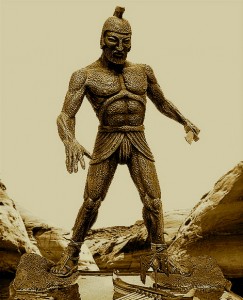 by Adrienne Mayor, Wonders & Marvels contributor
by Adrienne Mayor, Wonders & Marvels contributor
Uncanny mechanical humanoids, automatons, robots, and replicants, so popular in modern fiction and film, are usually thought to be inventions of the 17th century (Louis IV commissioned several mechanized figures). But the creation of artificial humans is a very ancient dream—or nightmare. Daedalus, the most ingenious inventor of Greek myth, was credited with making many marvelous mechanical wonders. His well-known experiment with man-made wings ended tragically with the death of his son Icarus., but Daedalus also created the first “living statues.” These realistic bronze sculptures appeared to be endowed with life as they moved their limbs, rolled their eyes, perspired, wept, and vocalized. Such animatronic statues were not just figments of the mythic imagination—they were actually constructed in classical antiquity.
Robots made to obey commands were also engineered by Hephaestus, the Greek god of invention and technology. Talos, the gigantic animated bronze warrior programmed to guard the island of Crete, was one of Hephaestus’s creations. Like Hollywood’s imaginary Robo-Cop or the Terminator, Talos was the ancient forerunner of autonomous cyborgs capable of deploying lethal force.
The physiology of Talos, described by ancient writers in mytho-bio-technical language, seems to presage today’s scientific “cybernetic organism” projects that employ neurological-computer interfaces to integrate living and non-living components. Hephaestus gave Talos a single internal artery or vein, through which ichor, the mysterious life-fluid of the gods, pulsed from his neck to his ankle. Talos’s biomimetic “vivisystem” was sealed by a single bronze nail.
Talos was tasked with hurling boulders at passing ships, including the Argo, manned by Jason and the Argonauts. But the most chilling ability of the huge biomechanical robot was a perversion of the universal gesture of human warmth, the embrace. Talos could heat his bronze body red-hot and then clasp a victim in his arms, hugging and burning him to death. How could Jason and the Argonauts escape from this bionic monster? Techno-wizard Medea to the rescue! Anticipating by more than 2,000 years HAL the doomed artificial intelligence computer of 2001: A Space Odyssey and the tragic replicants of Bladerunner, the sorceress Medea recognized the popular belief that that all artificial humanoids must harbor a deep desire to be real humans. Medea hypnotized Talos and convinced him that she could make him mortal by removing the bronze nail in his ankle. When this essential seal was dislodged, the ichor flowed out of Talos like molten lead, and his life ebbed away.
About the author: Adrienne Mayor is a Research Scholar in Classics and History of Science, Stanford University. She is the author of “Greek Fire, Poison Arrows & Scorpion Bombs: Biological and Chemical Warfare in the Ancient World” (2009) and “The Poison King: The Life and Legend of Mithradates, Rome’s Deadliest Enemy,” a nonfiction finalist for the 2009 National Book Award.
